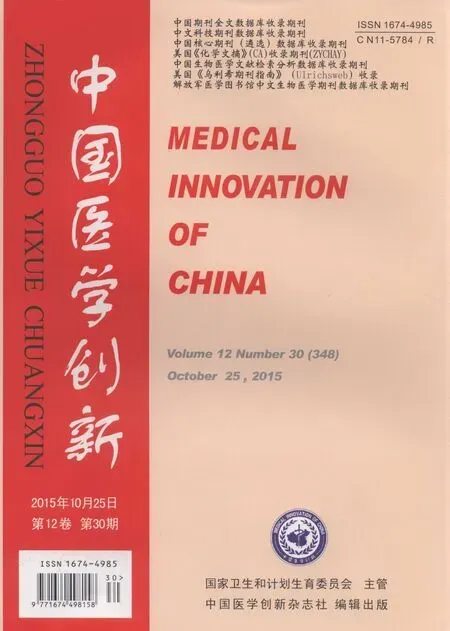转化生长因子β1与支气管哮喘的研究进展*
常琴田新瑞
转化生长因子β1与支气管哮喘的研究进展*
常琴①田新瑞①
支气管哮喘是一种慢性气道炎症,其主要病理改变包括气道炎症、平滑肌功能紊乱和气道重构。转化生长因子β1(TGF-β1)作为一种多效细胞因子,通过多种途径参与哮喘气道炎症反应和气道重构。本文就TGF-β1在哮喘气道炎症及气道重构中的作用及可能机制作一综述。
转化生长因子β1; 哮喘; 气道炎症; 气道重构
支气管哮喘简称哮喘,属于慢性气道炎症病变,涉及多种类细胞(如嗜酸性粒细胞、肥大细胞、T淋巴细胞、中性粒细胞、平滑肌细胞、气道上皮细胞等)和细胞因子。主要特征改变包括气道慢性炎症、气道高反应性(AHR)、可逆性气流受限及气道结构的改变,即气道重构。气道重构是气道反复损伤和修复的结果[1],其病理改变主要为上皮细胞损伤脱落,气道平滑肌增生、肥大,肌成纤维细胞增生及腺上皮化生等[2]。TGF-β1因其特有的促炎、抗炎及促纤维化作用,在哮喘发病中具有中心地位[3]。
1 TGF-β家族及其受体
TGF-β家族含有30余种蛋白成分,包括TGF-βs(TGF-β1、2、3)、骨形成蛋白、激活素、抑制素和其他结构相关因子,广泛存在于动物正常组织细胞及转化细胞中,以骨组织和血小板中最为丰富[4]。
T GF-βs主要存在于哺乳动物中[5]。其受体分为Ⅰ、Ⅱ、Ⅲ三种:I型受体又称为激活素受体样激酶(ALKs),有7种亚型(ALK1-7),且不同亚型参与不同的信号转导:ALK1、2、4、5、7主要转导TGF-β信号(ALK5为著);ALK3、6主要转导BMP信号。Ⅱ型受体是一种结构型丝/苏氨酸激酶,有TβR-Ⅱ、ActR-Ⅱ、ActR-ⅡB、BMPR-Ⅱ和AMHRA五种亚型,通过结合不同的家族成员介导不同的信号通路[6],主要通过跨膜的TGF-βI型受体(TβRI)和Ⅱ型受体(TβRⅡ)发挥作用[7]。
2 TGF-β1的结构特点及生物学作用
TGF-β1在进化中被高度保留,小鼠与人的TGF-β1中氨基酸序列相似度高达99%,而猪、牛、猴、鸡的相应序列与人类完全相同[4]。TGF-β1是一种由二硫键连接的碱性蛋白,基因位于人染色体19q3[8],该基因C端有5个明显的基因调控区:一个类增强子活性区,两个负调控区和两个启动子区。
TGF-β1具有多重生物效应,包括参与细胞增殖与分化、免疫功能抑制及细胞外基质形成、分泌,特别是在诱导上皮间质转化(EMT)中起关键作用。
3 TGF-β1发挥作用的通路
TGF-β1主要通过三条途径发挥作用:Smad通路、非Smad通路和Wnt/β-catenin通路。
3.1 Smad通路 Sekelsky等[9]在果蝇中发现恶性疾病相关性DNA结合蛋白MAD参与TGF-β的信号转导。目前在脊椎动物中共发现9种Smad蛋白,根据其功能可分为三类:一类是受体活化型,包括Smad1、2、3、5、8;第二类是通用调节型,Smad4;第三类为抑制型,包括Smad6、7。
TGF-β1与TβRI和TβRⅡ结合,形成异聚体复合物发挥作用。过程如下:TGF-β1首先与TβRⅡ结合,再激活募集TβRI形成受体复合物[10]。TβRⅡ
自身磷酸化,进而磷酸化TβRI的甘氨酸-丝氨酸富集区域(GS序列),同时活化TβRI的丝氨酸/苏氨酸活性[10]。活化的TβRI又磷酸化相关Smad蛋白。Smads蛋白是参与TGF-β1信号转导的主要因子,通过与细胞核内DNA分子结合发挥转录因子功能,激活的TGF-β1将信号放大,随之激活细胞内信号转导介质Smad2、3,磷酸化的 Smad2、3与 Smad4结合形成复合体,转移至细胞核内[11],与EMT等相关基因启动区的Smad4结合原件结合,调控EMT等相关基因的转录和表达,进而调节器官、组织纤维化过程。TGF-β1通过抑制型Smad发挥负性调节作用[12]。刺激后,Smad 7转移至胞浆,与胞浆内Smurf 2形成复合体,抑制R-Smads磷酸化,从而抑制TGF-β1通路的作用。
3.2 MAPK通路 MAPK通路可将细胞外信号转导至细胞及细胞核内,导致细胞增殖、分化、转化及凋亡等。TGF-β1激活促分裂原活化蛋白激酶(MAPK),主要包括细胞外信号调节激酶(ERK)、c-Jun氨基末端激酶(JNK)和P38分裂原活化的蛋白激酶通路[13]。ERKs通过磷酸化胞浆蛋白及核内的转录因子如c-Jun、EIK-1、c-myc和ATF2等,调控细胞增殖、分化;磷酸化ERKs上游蛋白(NGF受体、Raf-1、MEK等),对该通路进行负反馈调节。
研究发现,P38激活后,由胞质转至细胞核内,通过级联反应活化其下游转录因子,从而介导靶细胞分化、增殖、合成、分泌细胞外基质,诱导细胞凋亡及炎性反应等[14-15]。
3.3 Wnt通路 Wnt通路在胚胎发育、肿瘤发生和器官纤维化等重要生理及病理过程中发挥重要作用。Wnt信号通路未活化时,Gsk-3β在β-catenin的丝氨酸/苏氨酸残基添加磷酸基团,将β-catenin磷酸化,随之与β-TRCP蛋白结合,受泛素化的共价修饰,被蛋白酶降解。该通路激活后,Wnt与卷曲蛋白(Frz)结合,作用于细胞质中的蓬乱蛋白(Dsh),阻断β-catenin的降解,β-catenin在胞质及核中积聚,进而调控靶基因表达[16]。
4 TGF-β1在哮喘发病中的作用
哮喘是一种慢性气道炎症[17],其病理过程主要包括气道炎症,AHR及气道重构[18],是多种细胞和细胞因子共同参与、相互作用的结果。气道慢性炎症作为哮喘的基本特征,存在于所有的哮喘患者中,表现为炎症细胞浸润及气道分泌物增加等[18]。若哮喘长期反复发作,可见支气管平滑肌肥大、增生、气道上皮细胞黏液化生、上皮下胶原沉积和纤维化、基底膜增厚等气道重构的表现。
在哮喘炎症反应中,TGF-β1作为多种炎症细胞的强趋化因子和激活因子发挥作用。对哮喘患者支气管肺泡灌洗液(BALF)的研究发现,TGF-β1可促进炎症细胞水平的增加[19-21]。应原进入体内后,巨噬细胞浓度增加,诱发TGF-β1增加,诱导辅助性Th 17细胞扩大炎症反应[22-24]。活化的巨噬细胞和气道上皮细胞释放IL-18,可促进哮喘炎症反应的发生[25]。另一方面,TGF-β1可抑制多种炎性细胞的功能,通过负性调节作用降低AHR及气道炎症[26];同时抑制Th2细胞及IL-4、IL-5 等细胞因子的释放[23],在哮喘气道炎症中发挥作用。此外,TGF-β1作为一种有效的抗炎因子,其化学吸附能力可引起巨噬细胞和粒细胞在局部炎症反应中聚集[23],还可以促进Th17和FoxP3调节性T细胞的增殖、分化,从而诱导IL-9产生Th细胞[27-29],发挥免疫应答反应。
Simon等[18]利用OVA致敏Balb/c小鼠,建立小鼠慢性气道炎症模型,9周后收集BALF进行细胞计数,发现OVA致敏组小鼠BALF中嗜酸性粒细胞、中性粒细胞、淋巴细胞、巨噬细胞较正常对照组均明显增加;对肺组织进行免疫组化AB-PAS染色发现,OVA致敏组小鼠肺组织TGF高表达,与正常对照组比较差异有统计学意义(P<0.05)。表明TGF-β1在气道慢性炎症反应中发挥作用。
哮喘患者气道中TGF-β1水平显著高于正常个体[30]。TGF-β1具有强烈的促纤维化作用,能刺激气道平滑肌细胞增生,在气道重构中发挥作用[31]。实验发现,哮喘患者BALF中TGF-β1水平较正常组明显升高,与其下游信号通路TGF-β1/Smad活化成正相关[32]。TGF-β1通过调节炎症细胞表达、促进基质沉积、上皮下纤维化、平滑肌增生等参与哮喘气道重构[33]。
综上所述,T GF-β1作为一种多效细胞因子,在哮喘发病中发挥促炎、抗炎及促纤维化的作用。
5 TGF-β1在哮喘发病中的可能机制
近年来实验证明,TGF-β1主要通过Smad、非Smad和β-catenin三条通路在哮喘气道炎症及重构中发挥作用。
Sagara等[10]以磷酸化Smad2作为活性TGF-β信号转导的标记,对40例哮喘患者支气管活检标本研究发现,健康组中磷酸化Smad2表达水平低下,而哮喘组呈高表达。Rosendahl等[34]利用卵白蛋白(OVA)致敏、激发Balb/c小鼠,建立小鼠哮喘炎症阶段(4周)模型,观察肺组织中TGF-β1受体的表达,发现在小鼠气道上皮细胞、成纤维细胞和血管内皮细胞中磷酸
化Smad 2水平在吸入OVA后升高,而未吸入激发剂的致敏小鼠磷酸化Smad2则呈低表达;免疫组化法和RT-PCR均发现正常肺组织中几乎不表达Smad3,而哮喘小鼠肺组织中Smad3表达水平明显升高,证实Smad2和Smad3之间存在协同作用,且促进气道重构。此外,Nakao等[35]应用免疫组化法观察40例哮喘患者及6例正常个体的支气管活检标本,发现Smad蛋白主要表达于支气管上皮细胞,且哮喘组中Smad7蛋白表达水平较正常组低,W estern blot方法检测亦有相同结果。Ming Chen等[36]通过建立Balb/c小鼠OVA致敏哮喘模型(8周),观察小鼠BALF中TGF-β1含量(ELISA法)及肺组织中Smad7表达水平(Western Blot),发现OVA致敏组小鼠BALF中TGF-β1含量明显高于正常组,但其肺组织中Smad 7表达水平明显低于正常对照组,证实Smad7在哮喘发病中起保护性作用。说明,TGF-β1通过Smad通路在哮喘发病中发挥作用。
MAPK(特别是ERK1/2)是哮喘病理生理过程中重要的细胞内转导途径,但其机制尚不清楚[37]。但Ming等[37]通过实验证实,TGF-β1通过抑制NF-κB,而不是ERK1/2通路诱导大鼠气道上皮细胞增殖和迁移。Khalil等[38]通过建立大鼠肺纤维化模型,分别利用ELISA、Western Blot检测肺组织中TGF-β1总量及P38 MAPK的表达量,证实TGF-β1受体介导的P38 MAPK通路与肺纤维化过程密切相关,但在哮喘中的作用需进一步证实。
Tian等[39]通过蛋白敲除β-catenin,证实TGF-β1通过与β-catenin/Smad结合而非LEF-1发挥作用,且抑制β-catenin/Smad3相互作用可以分离TGF-β1的促纤维化及抗炎作用。
TGF-β1具有抗炎和促纤维化的双重作用,通过多种途径参与哮喘气道炎症反应和气道重构。TGF-β/ Smad信号通路在支气管哮喘的发生、发展中起重要作用,深入研究该信号通路对于开发以TGF-β1信号通路中的环节为靶点的靶向治疗具有积极意义。
[1] W arner S M,Knight D A.Airway modeling and remodeling in the pathogensis of asthma[J].Curr Opin Allergy Clin Immunol,2008,8(4):44-48.
[2] Bergeron C,Boulet L P.Structural changes in airway diseases:characteristics, mechanisms, consequences, and pharmacologic modulation[J].Chest,2006,129(4):1068-1087.
[3] A lcom J F,Rinaldi L M,Jaffe E F,et a1.T ransforming growth factor-betal suppresses airway hyperresponsiveness in allersic airway disease[J].A m J Respir Crit Care Med,2007,176(10):974-982.
[4] K rit Kitisin, Tapas Saha,et al.T GF-beta Signaling in Development[J]. Science Stke,2007,14(399):1126.
[5] M ark A,Travis,Dean Sheppard.TGF-β Activation and Function in Immunity[J].Annu Rev Immunol,2014,32(1):51-82.
[6] D erynck R,Feng X H. TGF-β receptor signaIing[J].Biochim Biophys Acta,1997,1333(2):105-150.
[7] Baardsnes J,Hinck C S,Hinck A P,et al.TbetaR-II discriminates the high-and low-affinity TGF-beta isoforms via two hydrogenbonded ion pairs[J].Biochemistry,2009,48(10):2146-2155.
[8] Sakaki-Yumoto M,Katsuno Y,Derynck R.TGF-β familu signaling in stem cells[J].Biochim Biophys Acta,2013,1830(2):2280-2296.
[9] Sekelsky J J,Newfeld S J,Raftery L A,et al.Genetic characterization and cloning of mothers against dpp, a gene required for decapentaplegic function in Drosophila melanogaster[J].Genetics,1995,139(3):1347-1358.
[10] Sagara H,Okada T,Okumura K,et al.Activation of TGF-beta/ Smad2 signaling is associated with airway remodeling in asthma[J].J Allergy Clin Immunol,2002,110(2):49-54.
[11] Le A V,Cho J Y,Miller M,et al.Inhibition of allergen-induced airway remodeling in Smad 3-deficient mice[J].J Immunol,2007,178(11):7310-7316.
[12] Yamada Y,Mashima H,Sakai T,et al.Functional roles of TGF-β1in intestinal epithelial cells through Smad-dependent and non-Smad pathway[J].Dig Dis Sci,2013,58(5):1207-1217.
[13] Chen H H,Zhou X L,Shi Y L,et al.Roles of p38 MAPK and JNK in TGF-β1-induced human alveolar epitheliak to mesenchymal transition[J].Arch Med Res,2013,44(2):93-98.
[14] M a F Y,Sachchithananthan M,Flanc R S,et al.M itogen activated protein kinases in renal fibrosis[J].Front Biosci,2009,18(1):171-187.
[15] C hopra P,Kanoje V,Semwal A,et al.Therapeutic potential of inhaled p38 mitogen-activated protein kinase inhibitors for inflammatory pulmonary diseases[J].Expert Opin Investig Drugs,2008,17(10):1411-1425.
[16] Anastas J N,Moon R T. Wnt signaling pathways as therapeutic targets in cancer[J].Nat Rev Cancer,2013,13(1):11-26.
[17] M azen Al-Alawi,Tidi Hassan,Sanjay H.Chotirmall.Transforming growth factor β and serve asthma:a perfect storm[J].Respiratory Medicine,2014,108(10):1409-1423.
[18] S imon G Royce,Krupesh P Patel,Chrishan S Sammuel. Characterization of a novel model incorporating airway epithelial and related fibrosis to the pathogenesis of asthma[J].Laboratory Investigation,2014,94(12):1326-1339.
[19] Duvernelle C,Freund V,Frossard N.Transforming growth factorbeta and its role in asthma[J].Pulm Pharmacol Ther,2003,16(4):181-196.
[20] Van Hove C L,Joos G F,Toumoy K G.Chronic inflammation in asthma:a constest of persistence vs resolution[J].Allergy,2008,63(9):1095-2109.
[21] H owell J E,McAnulty R J.T GF-beta:its role in asthma and therapeutic potential[J].Curr Drug Targets,2006,7(5):547-565.
[22] Vignola A M,Chanez P,Chiappara G,et al.Transforming growth factor-beta expression in mucosal biopsies in asthma and chronic bronchitis[J].Am J Respir Crit Care Med,1997,156(2 Pt 1):591-599.
[23] Y ang Y C,Zhang N,Van Crombruggen K,et al.T ransforming growth factor-betal in inflammatory airway disease:a key for understanding inflammation and remodeling[J].Allergy,2012,67(10):1193 -1202.
[24] C hakir J,Shannon J,Molet S,et al.Airway remodelingassociated mediators in moderate to severe asthma: effect of steroids on TGFbeta, IL-11, IL-17, and type I and type III collagen expression[J].J Allergy Clin Immunol,2003,111(6):1293-1298.
[25] Lee K S,Kim S R,Park S J,et al.A ntioxidant down-regulates interleukin-18 expression in asthma[J]. Mol Pharmacol,2006,70(4):1184-1193.
[26] Gras D,Bourdin A,Chanez P,et al.Airway remodeling in asthma:clinical and functional correlates[J].Med Sci,2011,27(11):959-965.
[27] Li M O,Wan Y Y,Sanjabi S,et al.T ransforming growth factorbeta regulation of immune responses[J].Annu Rev Immunol,2006,24(11):99-146.
[28] B ettelli E,Carrier Y,Gao W,et al.Reciprocal developmental pathways for the generation of pathogenic effector TH17 and regulatory T cells[J].Nature,2006,441(7090):235-238.
[29] Dardalhon V,Awasthi A,Kwon H,et al.IL-4 inhibits TGF-betainduced Foxp3t T cells and,together with TGF-beta,generates IL-9t IL-10t Foxp3(-) effector T cells[J].Nat Immunol,2008,9(12):1347-1355.
[30] Scherf W,Burdach S,Hansen G.Reduced expression of transforming growth factor beta 1 exacerbates pathology in an experimental asthma model[J].Eur J Immunol,2005,35(1):198-206.
[31] S tephen E,Bottoms,Jane E, et al.T GF-β1isoform specific regulation of airway inflammation and remodeling in a murine model of asthma[J].PLoS One,2010,5(3):e9674.
[32] X iong Y Y,Wang J S,Wu F H,et al.T he effects of –Praeruptorin A on airway inflammation, remodeling and transforming growth factor-beta/Smad signaling pathway in a murine model of allergic asthma[J].Int Immunopharmacol,2012,14(4):392-400.
[33] Postma D S,Timens W.Remodeling in asthma and chronic obstructive pulmonary disease[J].Proc Am Thorac Soc,2006,3(5):434-439.
[34] Rosendahl A,Checehin D,Fehniger T E,et a1.Activation of the TGF-beta/activin-Smad 2 pathway during allele airway inflarnmation[J].Am J Respir Cell Mol Biol,2001,25(1):60-68.
[35] Nakao A,Sagara H,Setoguchi Y,et a1.Expression of Smad 7 in bronchial epithelial cells is inversely correlated to basement mem brane thickness and airway hyperresponsiveness in patients with asthma[J].J Allergy Clin Immunol,2002,110(6):873-878.
[36] Mi ng Chen,Zhiqiang Lv,Shanping Jiang.The effect of triptolide on airway remodeling and transforming growth factor-β1/Smad signaling pathway in ovalbumin-sensitized mice[J].Immunology,2011,132(3):376-384.
[37] Mi ng Chen,Jian Ting Shi,Zhi Qiang Lu,et al.Tr iptolide inhibits TGF-β1induced proliferation and migration of rat airway smooth muscle cells by suppressing NF-κB but not ERK1/2[J].Immunology,2014,29(3):1111.
[38] Kh alil N,Xu Y D.Pr oliferation of pulmonary interstitial fibroblasts is mediated by transforming growth factor-betainduced release of extracellular fibroblast growth factor-2 and phosphorylation of p38 MAPK and JNK[J].Biol Chem,2005,280(5):43 000-43 009.
[39] Tian Xi nrui,Zhang Jianlin,Thian Kui Tan,et al.As sociation of b-catenin with P-Smad3 but not LEF-1 dissociates in vitro profibrotic from anti-inflammatory effects of TGF-β1[J].Jo urnal of Cell Science,2013,126(1):67-76.
The Research Progress of Transforming Growth Factor-β1and Bronchial Asthma/
CHANG Qin,TIAN Xin-rui.//Medical Innovation of China,2015,12(30):146-149
Asthma is a chronic airway inflammation,the main pathological changes includes airway inflammation,smooth muscle dysfunction and airway remodeling.As a pleiotropic cytokine,TGF-β1involves in airway inflammation response and airway reconstruction through various pathways.This paper reviews the effect and potential mechanism of TGF-β1in airway inflammation and remodeling.
TGF-β1; Asthma; Airway inflammation; Airway remodeling
10.3969/j.issn.1674-4985.2015.30.049
2015-03-17) (本文编辑:陈丹云)
山西省自然科学基金(2013011055-1)
①山西医科大学第二医院 山西 太原 030001
田新瑞
First-author’s address:The Second Hospital of Shanxi Medical University,Taiyuan 030001,China

